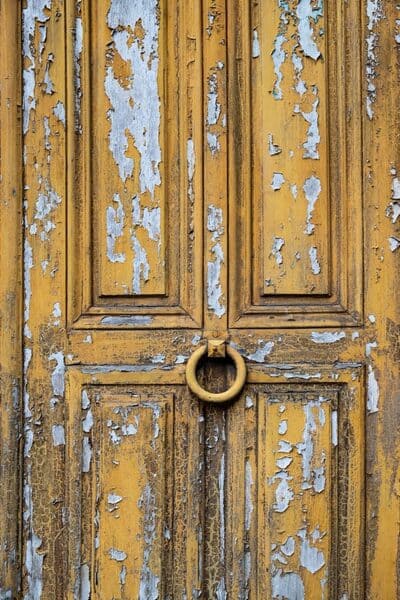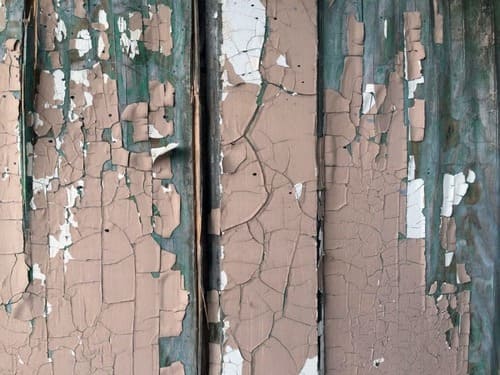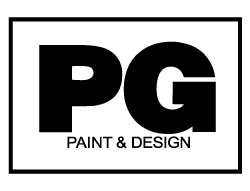Cracking paint is caused by lack of using a paint primer, poor paint application, and or use of a low quality product along with the lack of preparing the surface before painting it. Flaking paint is what follows cracked paint once it begins to peel. Commonly referred to as paint failures by painting professionals these types of paint problems although unsightly are easily fixed.
Here is what you need to know to avoid the paint from cracking or flaking, and why it needs to be fixed.
Causes of Cracking and Flaking Paint Problems
Cracked paint leads to flaking and peeling paint problems that make any interior or exterior painting look unprofessional and make it seem like no home maintenance is ever done. Without the proper surface preparation, and the know how to fix it before it gets out of control and becomes an unsightly eyesore becomes a bigger project than imagined.
When paint cracks or flakes it can be caused from improper application of the paint. Lack of using the right paint primer and paint finish or simply aging paint can cause paint to flake or crack. These issues may start off as small problems that one may think is not really important to fix, but leaving it unrepaired will cause it to worsen over time.
Other causes and reasons why paint cracks or flakes are:
Moisture – Water and humidity are a big problem for paint. When painting areas that are damp or exposed to high levels of humidity they can easily peel. Making sure to use the best quality of paints for the appropriate areas is key to avoiding and interior paint from peeling as well as prevent any issues with mold and mildew. Ensuring that exterior painting only occurs when it has not been raining for at least two to three days so as to ensure the wood surfaces are completely dry before any painting is done. It is also not recommended to be painting any exterior surfaces in high humid temperatures as there will be poor adhesion of the paint to the surface.
Poor Surface Prep – Making sure the surfaces to be painted are clean and clear of any dust and grime and properly primed will avoid the issues of having the paint crack or flake away.
Expired Paint – Using the best quality paints and ensuring that it has not expired will prevent the issue of peeling paint. Expired paints are past their prime quality and will result in poor painting adhesion, as well as coverage issues. Buy new paint if you are wanting to avoid paint problems and issues. Make sure to properly dispose of left over or expired paint at your local Ottawa hazardous waste depot.
Before having to deal with any of these unsightly problems and issues, you can hire professional painters with experience in interior drywall repair, as well as the knowledge to advise on the best solutions for any exterior paints.
How To Fix Flaking, Cracking or Peeling Paint
Simply painting over any cracked, flaky or peeling paint will not resolve the issue, in fact it will cause it to become a bigger problem. Issues will arise from the new paint not adhering to the surface unless you have removed the flaking peeling paint and prepped the surface properly. It is important that the old flaking paint is scraped off first before painting over the area.
If you are the DIY type painter, here are a few tips you can follow to ensure you repair the problem properly, and prevent it from happening again.
- Never apply oil based paints over a latex based paint
- Apply minimum of two coats of paint over a properly primed surface.
- Use high quality paints that provide good coverage and prevent you from having to paint often
- Allow enough time in between coats of interior or exterior paint to dry completely. Failure to allow sufficient drying time in between the application of paint coats will cause poor adhesion, followed by paint problems such as peeling, cracking, flaking, sticking or blistering bubbles.
- Remove the loosened or flaking paint with a scraper for interior paint or wire brush exterior paint.
- Sand the area to smooth everything out. Patch any drywall compound to create a smooth surface on any interior walls or ceilings and use a filler if necessary after scraping off several layers of old paint.
- Use a good paint primer to ensure the best protection to the surface and the best adhesion of your final paint finish.
When To Call On Professional Help
If unsure about whether the problem is a simple failure of the paint adhering properly to the surface, or lack of using good quality paints or not preparing the surface area, calling on professional help may be the answer to ensuring there are no bigger issues such as structural damage that may be causing the paint to crack, peel or flake.
If you feel uncertain as to whether you can or should tackle a project yourself, feel free to reach out to a painting professional you can trust.
Schedule a Free Painting Estimate
This post was originally published on Jul 13, 2015 and edited on April 04, 2020
